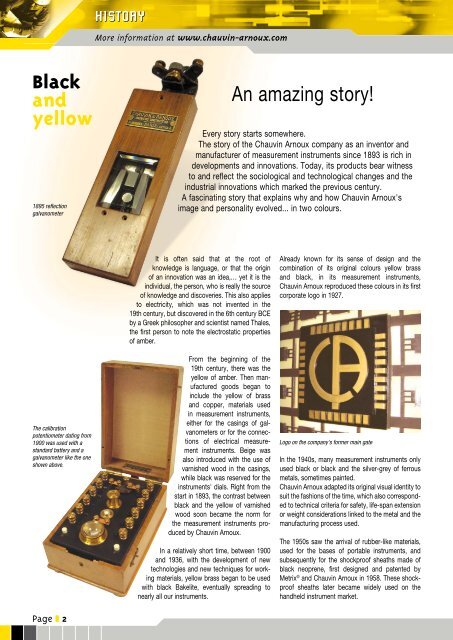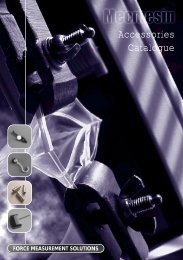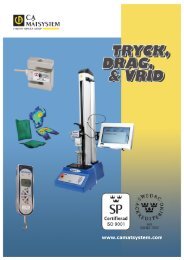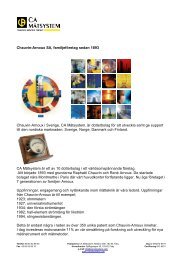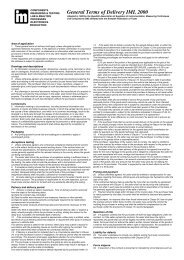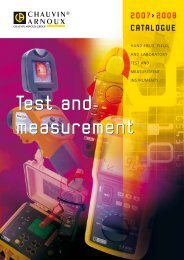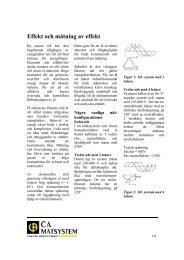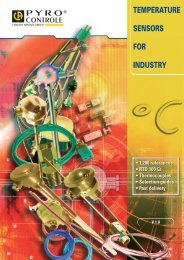Test & Measurement - Chauvin-Arnoux i Skandinavien
Test & Measurement - Chauvin-Arnoux i Skandinavien
Test & Measurement - Chauvin-Arnoux i Skandinavien
You also want an ePaper? Increase the reach of your titles
YUMPU automatically turns print PDFs into web optimized ePapers that Google loves.
historY<br />
More information at www.chauvin-arnoux.com<br />
Black<br />
and<br />
yellow<br />
1895 reflection<br />
galvanometer<br />
An amazing story!<br />
Every story starts somewhere.<br />
The story of the <strong>Chauvin</strong> <strong>Arnoux</strong> company as an inventor and<br />
manufacturer of measurement instruments since 1893 is rich in<br />
developments and innovations. Today, its products bear witness<br />
to and reflect the sociological and technological changes and the<br />
industrial innovations which marked the previous century.<br />
A fascinating story that explains why and how <strong>Chauvin</strong> <strong>Arnoux</strong>'s<br />
image and personality evolved... in two colours.<br />
The calibration<br />
potentiometer dating from<br />
1900 was used with a<br />
standard battery and a<br />
galvanometer like the one<br />
shown above.<br />
Page z 2<br />
It is often said that at the root of<br />
knowledge is language, or that the origin<br />
of an innovation was an idea,… yet it is the<br />
individual, the person, who is really the source<br />
of knowledge and discoveries. This also applies<br />
to electricity, which was not invented in the<br />
19th century, but discovered in the 6th century BCE<br />
by a Greek philosopher and scientist named Thales,<br />
the first person to note the electrostatic properties<br />
of amber.<br />
From the beginning of the<br />
19th century, there was the<br />
yellow of amber. Then manufactured<br />
goods began to<br />
include the yellow of brass<br />
and copper, materials used<br />
in measurement instruments,<br />
either for the casings of galvanometers<br />
or for the connections<br />
of electrical measurement<br />
instruments. Beige was<br />
also introduced with the use of<br />
varnished wood in the casings,<br />
while black was reserved for the<br />
instruments' dials. Right from the<br />
start in 1893, the contrast between<br />
black and the yellow of varnished<br />
wood soon became the norm for<br />
the measurement instruments produced<br />
by <strong>Chauvin</strong> <strong>Arnoux</strong>.<br />
In a relatively short time, between 1900<br />
and 1936, with the development of new<br />
technologies and new techniques for working<br />
materials, yellow brass began to be used<br />
with black Bakelite, eventually spreading to<br />
nearly all our instruments.<br />
Already known for its sense of design and the<br />
combination of its original colours yellow brass<br />
and black, in its measurement instruments,<br />
<strong>Chauvin</strong> <strong>Arnoux</strong> reproduced these colours in its first<br />
corporate logo in 1927.<br />
Logo on the company's former main gate<br />
In the 1940s, many measurement instruments only<br />
used black or black and the silver-grey of ferrous<br />
metals, sometimes painted.<br />
<strong>Chauvin</strong> <strong>Arnoux</strong> adapted its original visual identity to<br />
suit the fashions of the time, which also corresponded<br />
to technical criteria for safety, life-span extension<br />
or weight considerations linked to the metal and the<br />
manufacturing process used.<br />
The 1950s saw the arrival of rubber-like materials,<br />
used for the bases of portable instruments, and<br />
subsequently for the shockproof sheaths made of<br />
black neoprene, first designed and patented by<br />
Metrix ® and <strong>Chauvin</strong> <strong>Arnoux</strong> in 1958. These shockproof<br />
sheaths later became widely used on the<br />
handheld instrument market.


